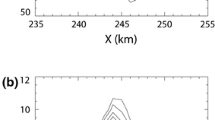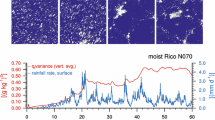Abstract
In the Earth’s atmosphere, Cumulus clouds are often modeled as an ensemble of statistically stationary moist plumes in a stratified environment. The entrainment rate coefficient for a plume relates the rate of change of volume flow rate along the plume axis to the center-line velocity and plume width. Its value determines the rate at which each plume gets diluted by the environment, and, consequently, the height of each plume. General Circulation Models typically assume a constant, empirically determined value of entrainment rate coefficient along cloud depth, which is the same for all plumes. In this work, data from Large Eddy Simulation of non-precipitating shallow Cumulus clouds is used to obtain an energy consistent closure for entrainment rate coefficient along the cloud depth in terms of the source terms in the mean momentum and vertical energy equation. The relative humidity of the environment is systematically varied over a set of three simulations, in which the control case corresponds to the Barbados oceanographic and meteorological experiment. A non-linear dependence of the local entrainment rate in terms of the local Richardson number is postulated for updraft patches, and the model constants are dynamically extracted from the relevant source terms in momentum and energy equation using the energy consistent approach. This model allows updraft patches to have a positive local entrainment rate even when the average entrainment rate for the ensemble of updrafts is negative. The resulting entrainment model for individual updraft patches may be used to obtain the fractional entrainment and detrainment rates of the cloud ensemble. The model yields reasonably low a posteriori error, especially for positively buoyant updrafts.







Similar content being viewed by others
References
Agrawal A, Prasad AK (2004) Evolution of a turbulent jet subjected to volumetric heating. J Fluid Mech 511:95–123
Arakawa A, Schubert WH (1974) Interaction of a cumulus cloud ensemble with the large-scale environment, part i. J Atmos Sci 31(3):674–701
Aspden AJ, Nikiforakis N, Bell JB, Dalziel SB (2017) Turbulent jets with off-source heating. J Fluid Mech 824:766–784
Baba Y (2019) Spectral cumulus parameterization based on cloud-resolving model. Clim Dyn 52(1–2):309–334
Baba Y (2020) Diurnal cycle of precipitation over the maritime continent simulated by a spectral cumulus parameterization. Dyn Atmos Oceans 91:101160
Bera S, Prabha TV (2019) Parameterization of entrainment rate and mass flux in continental cumulus clouds: Inference from large eddy simulation. J Geophys Res Atmos 124(23):13127–13139
Bhat GS, Narasimha R (1996) A volumetrically heated jet: large-eddy structure and entrainment characteristics. J Fluid Mech 325:303–330
Bryan GH (2017) The governing equations for cm1. National Center for Atmospheric Research, 24
Bryan GH, Fritsch JM (2002) A benchmark simulation for moist nonhydrostatic numerical models. Mon Weather Rev 130(12):2917–2928
Ciriello F, Hunt G (2020) Analytical solutions and virtual origin corrections for forced, pure and lazy turbulent plumes based on a universal entrainment function. J Fluid Mech 893
Craske J, van Reeuwijk M (2015) Energy dispersion in turbulent jets part 1 direct simulation of steady and unsteady jets. J Fluid Mech 763:500–537
Craske J, Salizzoni P, van Reeuwijk M (2017) The turbulent Prandtl number in a pure plume is 3/5. J Fluid Mech 822:774–790
Dawe J, Austin P (2013) Direct entrainment and detrainment rate distributions of individual shallow cumulus clouds in an LES. Atmos Chem Phys 13(15):7795–7811
de Roode SR, Siebesma AP, Jonker HJ, de Voogd Y (2012) Parameterization of the vertical velocity equation for shallow cumulus clouds. Mon Weather Rev 140(8):2424–2436
de Rooy WC, Siebesma AP (2010) Analytical expressions for entrainment and detrainment in cumulus convection. Q J R Meteorol Soc 136(650):1216–1227
Deardorff JW (1980) Stratocumulus-capped mixed layers derived from a three-dimensional model. Bound-Layer Meteorol 18:495–527
Del Genio AD, Wu J (2010) The role of entrainment in the diurnal cycle of continental convection. J Clim 23(10):2722–2738
Devenish B, Rooney G, Thomson D (2010) Large-eddy simulation of a buoyant plume in uniform and stably stratified environments. J Fluid Mech 652:75–103
Drueke S, Kirshbaum D, Kollias P (2019) Evaluation of shallow-cumulus entrainment rate retrievals using large-eddy simulation. J Geophys Res Atmos 124(16):9624–9643
Drueke S, Kirshbaum DJ, Kollias P (2020) Environmental sensitivities of shallow-cumulus dilution-part 1: selected thermodynamic conditions. Atmos Chem Phys 20(21):13217–13239
Fox DG (1970) Forced plume in a stratified fluid. J Geophys Res 75(33):6818–6835
Gerber HE, Frick GM, Jensen JB, Hudson JG (2008) Entrainment, mixing, and microphysics in trade-wind cumulus. J Meteorol Soc Jpn Ser II 86:87–106
Holland JZ, Rasmusson EM (1973) Measurements of the atmospheric mass, energy, and momentum budgets over a 500-kilometer square of tropical ocean. Mon Weather Rev 101(1):44–55
Kaminski E, Tait S, Carazzo G (2005) Turbulent entrainment in jets with arbitrary buoyancy. J Fluid Mech 526:361–376
Kewalramani G, Pant CS, Bhattacharya A (2022) Energy consistent Gaussian integral model for jet with off-source heating. Phys Rev Fluids 7(1):013801
Krug D, Chung D, Philip J, Marusic I (2017) Global and local aspects of entrainment in temporal plumes. J Fluid Mech 812:222–250
Lu C, Liu Y, Yum SS, Niu S, Endo S (2012) A new approach for estimating entrainment rate in cumulus clouds. Geophys Res Lett 39(4)
Morton BR, Taylor GI, Turner JS (1956) Turbulent gravitational convection from maintained and instantaneous sources. Proc R Soc Lond Ser A Math Phys Sci 234(1196):1–23
Neggers R, Duynkerke P, Rodts S (2003) Shallow cumulus convection: A validation of large-eddy simulation against aircraft and Landsat observations. Quart J R Meteorol Soc J Atmos Sci Appl Meteorol Phys Oceanogr 129(593):2671–2696
Pant CS, Bhattacharya A (2018) Evaluation of an energy consistent entrainment model for volumetrically forced jets using large eddy simulations. Phys Fluids 30(10):105107
Priestley CHB, Ball FK (1955) Continuous convection from an isolated source of heat. Q J R Meteorol Soc 81(348):144–157
Romps DM (2010) A direct measure of entrainment. J Atmos Sci 67(6):1908–1927
Siebesma AP, Bretherton CS, Brown A, Chlond A, Cuxart J, Duynkerke PG, Jiang H, Khairoutdinov M, Lewellen D, Moeng C-H et al (2003) A large eddy simulation intercomparison study of shallow cumulus convection. J Atmos Sci 60(10):1201–1219
van Reeuwijk M, Craske J (2015) Energy-consistent entrainment relations for jets and plumes. J Fluid Mech 782:333–355
van Reeuwijk M, Salizzoni P, Hunt GR, Craske J (2016) Turbulent transport and entrainment in jets and plumes: A DNS study. Phys Rev Fluids 1(7):074301
Vraciu CV (2022) On the energy-consistent plume model in the convective boundary layer. Dyn Atmos Oceans 100:101330
Zhang GJ, McFarlane NA (1995) Sensitivity of climate simulations to the parameterization of cumulus convection in the Canadian Climate Centre general circulation model. Atmos Ocean 33(3):407–446
Acknowledgements
The author acknowledges support for the project from the Department of Science and Technology, India (sanction letter number DST/CCP/ NCM/66/2017). The author is also grateful to Prof. Sandeep Sahany for discussions on modeling Cumulus clouds in GCMs. AB also acknowledges support from DST Center of Excellence in Climate Modeling at I.I.T. Delhi.
Funding
This work was supported by the Department of Science and Technology, India (sanction letter number DST/CCP/ NCM/66/2017)
Author information
Authors and Affiliations
Contributions
The author Amitabh Bhattacharya generated the data, performed the analysis, wrote the main manuscript and prepared all the figures.
Corresponding author
Ethics declarations
Conflicts of interest
The authors report no conflict of interest to declare that are relevant to the content of the article.
Additional information
Publisher's Note
Springer Nature remains neutral with regard to jurisdictional claims in published maps and institutional affiliations.
Rights and permissions
Springer Nature or its licensor (e.g. a society or other partner) holds exclusive rights to this article under a publishing agreement with the author(s) or other rightsholder(s); author self-archiving of the accepted manuscript version of this article is solely governed by the terms of such publishing agreement and applicable law.
About this article
Cite this article
Bhattacharya, A. Evaluation of energy consistent entrainment rate closure for cloudy updrafts. Environ Fluid Mech (2024). https://doi.org/10.1007/s10652-024-09972-2
Received:
Accepted:
Published:
DOI: https://doi.org/10.1007/s10652-024-09972-2




